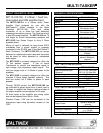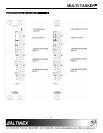
MULTI-TASKER
9
9
7.2 DESCRIPTION OF COMMANDS
Each command consists of three parts: function,
card ID, and unit ID. [Function, Card ID, Unit ID]
Example:
[VERC3U2]
VER = Function
C3 = Card ID
U2 = Unit ID
For detailed information regarding function, see
each command description.
Card ID is an assigned value from 1 to 19, which
represents the number of slots. Card ID 0 (C0) is
used for the controller (see user’s guide for the
MT100-100). Changing the position of a card will
significantly affect the commands recorded on
software definitions or a third party control system.
Unit ID has a value from 0 to 9. Unit ID 0 should be
used for single unit operation. If the Unit ID is set to
0, then each command can be used without Ui (use
command [SETU0]; see user’s guide for the MT100-
100).
Example:
[VERC3]: for unit ID zero
[VERC3Ui]: for unit ID other than zero
[VERC3]: equivalent to
[VERC3U0]
1. [VERCnUi]
This command receives the software version
and card type for the
MT113-102/103
card.
Cn = card ID number (n = # from 1 to 19)
Ui = Unit ID (i = # from 0 to 9) (refer to the
MT100-100 user’s guide for explanation)
Example:
If one
MT113-102
card is in slot #2.
To send command
[VERC2]
,
the Multi-Tasker™
Enclosure will return:
[MT113-102 VER: 690-0133-007 C02]
2. [CnUi]
This command receives the status of the card.
Command Format: [CnUi]
Cn = card id (n = 1 to 19)
Ui = unit id (i = from 0 to 9) (refer to the MT100-
100 user’s guide for explanation)
Example:
If one
MT109-102
card is in slot #2 of unit 3 with
input 1 ON:
To send command
[C2U3]
,
the Multi-Tasker™
Enclosure will return feedback information about
card status, which will display all current
settings:
VOLIN1:16
VOLIN2:16
VOLIN3:32
VOLOUT:12
BASS:8
TREBLE:14
LOUDNESS:ON
If there is no card in slot #2 of unit 3, sending
the
[C2U3]
command will not return any
feedback.
3. [CnS]
This command is to save card status such as
ON/OFF, IN/OUT, and volume control where
applicable.
4. [SELmCnUi]
This command sets path to adjust the individual
volume level for single card. Command Format:
[SELmCnUi] [–] [–] [–] [–] or [+] [+] [+] [+]
m = Input number (m = 1 to 3)
n = Card ID number (n = slot # from 1 to 19)
i = Unit ID number (i = 0 to 9)
+ = increases volume. (maximum of 15 levels
for audio).
– = decreases volume. (maximum of 15 levels
for audio).
Example:
If the status of audio card 5 of unit zero is as
follows:
VOLIN1:16
VOLIN2:16
VOLIN3:32
VOLOUT:12
BASS:8
TREBLE:14
LOUDNESS:ON


















